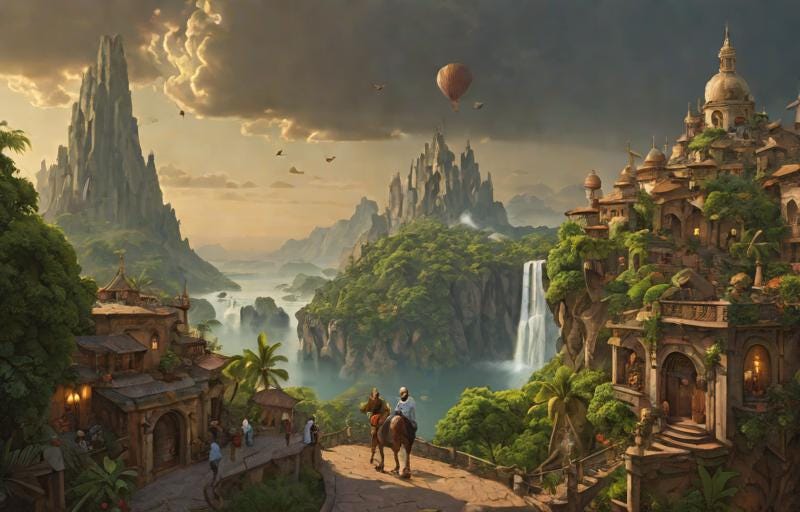A to B isn't B to C
“You do what you can for as long as you can, and when you finally can’t, you do the next best thing...” ― Chuck Yeager
Musical chairs
Earlier this year, I was at a party with folks from church and a game of Musical Chairs was being played. Musical Chairs is a game where a set of players dance around a smaller number of chairs arranged in a circle and facing outwards. Each round, the music is stopped at a random interval and players last to be seated and without seats are eliminated. Although I wasn’t in the game, I noticed the strategy a friend of mine, Mr. Bean, was using.
Starting with 12 players, 7 rounds later and down to 5 players, I observed Mr Bean only moved (danced) to the next seat when it was already empty, which guaranteed he always had somewhere to sit when the music went off at a good enough angle - letting him stay in the game and survive to this point. As expected, he made it to the last round where he went head to head with one final opponent. At this point, he had moved from the A to the B stage of gameplay. In the final round, when the music stopped, Mr Bean’s opponent went dirty by grabbing the chair and pulling it out from underneath Mr Bean and consequentially, Mr Bean fell to the ground while trying to sit down, and the opponent won. Just as Mr Bean figured out a successful strategy to win at all hands cast between point A to B, the last stage of the game required a different strategy.
Life’s journey
Navigating through life's journey is marked by complexity and non-linearity, a concept that I will encapsulate by the saying, "What took you from point A to point B can often not take you from point B to point C." This metaphorical expression reflects the dynamic of growth and development in various aspects of life, from everyday activities like games and personal evolution, to educational progression and professional advancement.
In the nascent stages of any journey, the methods and strategies we employ can often be developed through rudimentary logic (common sense). They serve a singular purpose; to guide us from a state of unknowing, or point A, to a state of elementary understanding or consistent basic accomplishment, known as point B. These tools could range from initial research and basic skills training to rudimentary tactics in games we play with other people. At this stage, the focus is on establishing a solid foundation to be in a comfortable place, and ideally, a foundation upon which further development can be built.
However, a common pitfall many of us encounter is the temptation to rely on these initial strategies for continued growth and success. Once we achieve point B, we may erroneously believe that the same strategies and tools that helped us initially will continue to serve us well. This is where many of us stumble. The skills and strategies that brought us to point B may not be sophisticated or nuanced enough to counter the new or unforeseen challenges that emerge as we strive to reach point C.
“The art of life lies in a constant readjustment to our surroundings.”
― Kakuzo Okakura
For example, as a student I discovered that the study habits that facilitated my success in high school, leading them from point A to point B, were inadequate to meet the demands of university-level coursework, the journey from point B to point C. In college, I was unable to grasp all concepts delivered in the classroom and needed to study outside what was available in lecture notes. In the same vein, when I became a professional, the technical skills that secured my first job, a transition from point A to point B, were not sufficient for higher-level roles that necessitate strategic thinking, people management, negotiation, and conflict resolution skills. In continually building everyday relationships, I find that I am required to communicate more clearly, carve out time to spend on relationships, and also understand individual needs, over just performing lower effort acts of kindness. These scenarios illustrate the necessity for continuous growth and adaptation I have observed in my personal life.
As we transition from one stage to the next, we must be open to developing new strategies, acquiring different skills, and expanding our knowledge base. This could involve actively seeking out learning opportunities (especially from failures), finding mentorship, or demanding to necessitate a complete shift in mindset or approach.
Our flexibility
Furthermore, it is not just about acquiring new skills and models for life, but also about discarding or modifying old ones that no longer serve us (well). It is about recognizing that what worked once may not work again, and the importance of being open to new ways of thinking and doing. As we evolve, so should our models, strategies and our skillset.
“A man is worked upon by what he works on. He may carve out his circumstances, but his circumstances will carve him out as well.”
― Frederick Douglass
The journey of life is a continuous process of learning, growth, and adaptation. The strategies that take us from point A to point B serve their purpose for that segment of the journey. When we aspire to move from point B to point C, we must be ready to be flexible enough to meet new challenges and opportunities head-on.
Life is not a straight line, but a winding path that requires adaptability, resilience, and the willingness to learn and change who we are.





